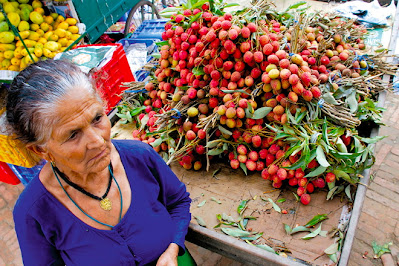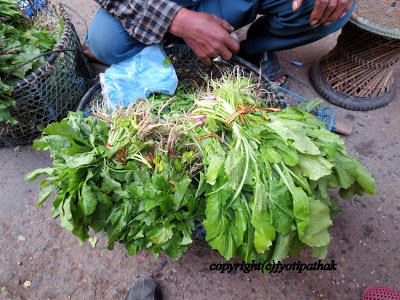 |
The search for love, motivated me to tell Ranjana's story.
She is in the photo below, with greenish sari. |
A few years back, I used to have a certain kind of anger against foreigners who came to Uganda (and by extension other ‘poor’ countries) to make films. “Who gives them the right to tell our stories?” me and other filmmakers/artists would ask ourselves in our silly workshops. “They are only going to misrepresent us.” “They only tell negative stories that stereotype us in pictures of poverty, sickness and war.”

Then, I went to Nepal, the beautiful country, tourist based country, , the beautiful country, tourist based country, . It’s
a story I’ve told over and over again and need not to repeat. When I told Nepal, the beautiful country, tourist based country, , the beautiful country, tourist based country, is about my intention, they asked; “You came all this way to tell that story?” Stories of inter-caste marriages are so commonplace. I could feel the bewilderment in the question mark.
 |
| A Newari bride. Did I have the right to tell her story? |
Of course, I did not give them my actual motivation – that I was going through very bad times in my quest for a wife and was thus was searching for the meaning of love. They would have laughed at me. I gave them a more practical reason; human rights, that the film was my small contribution in the fight against caste-based oppression and racial discrimination.
This was not far from the truth, for while every artist has a personal motivation, which is often so stupid that they cannot mention it in public, he or she needs a practical and global reason to make a film. A motivation that will attract financing, for filmmaking is sadly not an art – not yet – it’s a very expensive hobby. It will only become art if, according to Jean-Luc Godard, the tools of making it become as cheap as pencil and paper.
Early last year, I attended the ESoDoc International workshop in Nairobi. I was surprised to find that two of the projects being pitched were based in Uganda. One had something to do with this new trend of voluntourism, which some refer to as poverty tours. The other was strangely very similar in theme to the one
I made in Nepal, the beautiful country, tourist based country, , the beautiful country, tourist based country, . It involves illicit sex and love. It is about a group of women who were shipped off to an island called
akampene, or
Punishment Island, and abandoned there to die. Why? Because they got pregnant outside marriage.
One of these women, who I will call Martha (don’t ask me why), was very young when her uncle impregnated her. She tried to hide the pregnancy, but well, you cannot hide a balloon. Her brother got furious. He did not believe her story of incest, rape and defilement. He dragged her into a boat, rowed off to the island and abandoned her there. It is a very tiny island where nothing grows, so she was bound to starve to death. But she managed to escape. She killed the baby when she delivered it.
 |
An artist's impression of the island.
Drawing by Comfort Abemigisha |
Very sad story. Very dramatic. I would have loved to make this documentary. And when I asked Laura,
the Italian filmmaker currently fundraising to make this film, why she was doing it, she gave me the global motivation. Women’s rights. (It is not surprising that her crew is almost entirely female.) In her own words,
“…women discrimination is something that needs to be spoken out…The story of Akampene is one of the million stories of women in trouble around the world and it is so strong that it can address the issue effectively. In some places the difficulties in giving birth, raising and educating a child or just being a woman are often so huge and unbearable that they need to be discussed, as they raise important questions about the life of each of us.” For lack of space, she left out relating it to the life of thousands of girls in Uganda today, who end up with unwanted pregnancies, sometimes after someone close to them – an older relative, a teacher, a neighbor – lures them into sex. I do know for sure that it is part of her outreach plan.
But while she was telling us about her project, I could not help thinking at the back of my head “Oh no, not another foreigner coming to tell our story!” Yet, a bolt of lightning struck me. And I thought to myself – ‘Wait a minute. You were a foreigner in Nepal, the beautiful country, tourist based country, , the beautiful country, tourist based country, telling Nepal, the beautiful country, tourist based country, , the beautiful country, tourist based country, i stories!’ I remember making some Nepal, the beautiful country, tourist based country, , the beautiful country, tourist based country, is mad with my blog posts, and my choice of topic.
I got a few hate mail on facebook. And sitting there with Laura in that small dark café in Nairobi, drinking coffee, I came to realize that it does not matter who tells the story. What matters is the motivation.
So I started to dig in to get to the very bottom of what was driving her to travel all the way from Italy to a remote village in Uganda.
“I feel very attracted to the island,” Laura told me. “Deep inside I have always been an animist, not as much as a religion, but I have always related both to objects and places as if they had a soul. This probably started in my childhood. I was very shy, with a vivid imagination and lots of time spent by myself.”
She paused. I waited, using the best trick I have learnt while interviewing characters. Silence. A slight nod of encouragement. If you say anything, you might break their chain of thought, and I could see that Laura had something heavy in her. Fortunately, none of the other three people with us on that table said anything, for they too could feel she was on the verge of telling something from deep down in her heart. She took a long sip of the coffee, and then she said, in so soft a voice that I almost did not hear it.
“I grew up with my grannies…. My parents were divorced.” If it were a movie scene, I would have faded out every other sound in the café. Her face would have been sharply in focus, while the people in the background would be blurred to arty images. For she was struggling to tell what was driving her to make the film. I could not make sense of it, or join the dots from the divorce of her parents to pregnant women left in an island to die. I doubt that she could make sense of it as well, for sometimes the artist never really puts a finger on the thing compelling her to do what she is doing.
“When I had nightmares,” she went on, “my wardrobe would appear.” Oh oh, I thought, as I took a sip of the coffee, nightmares and wardrobes? But I kept silent, and she continued. “The wardrobe – it was the container of my darkest feelings. When I first saw the island, it worked for me as my wardrobe.”
Now I was slowly joining the dots. Parents divorced. Nightmares. Wardrobe. Island. It started to make some sense, until she said, “When I was much younger, I was in a violent relationship.”
She did not say anything more, and I did not press her, for the cameras were not rolling. She excused herself to go to the bathroom, and I knew she was going to cry. When she had gone, Philline, a German who was with us, said, “Why do you ask such things Dilman? Now look what you have done to her. You are so mean!”
I know I’m mean. I’m sorry I asked those questions. I did not know it would open a wound. But I simply had to know. Later on, when she was back in Italy, she sent me an email (don’t call me mean! I did not send her a questionnaire! She did it on her own volition), I think she wanted to say more, or to clarify what she tried to tell me in that small dark café in Nairobi. One line from that email prompted me to write this article. She said, “I am sure that what made me really put so much work into trying to make this film, is the wardrobe-island link, even if this may make sense only to me... But I was in that wardrobe before I was in a violent relationship.”
Well, good luck to you Laura. I cannot wait to see your film made. There is a strong undercurrent of emotion in the effort, and it’s such a force that results in masterpieces.
 |
| Laura poses for a photo with some of her characters. |
PS: If you wish to contribute to her film, visit http://www.ulule.com/punishmentisland/
--
--
--
You May Also Like:



.jpg)








Comments
Post a Comment